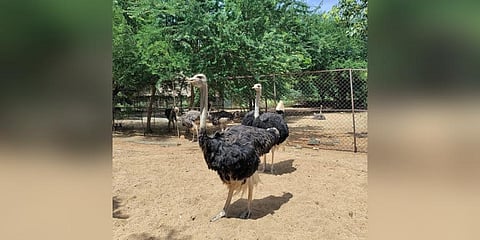

CHENNAI: The Arignar Anna Zoological Park, popularly known as Vandalur Zoo, has become the most successful zoo in the country in breeding Ostriches, the world’s largest and heaviest bird. Though there is no dedicated conservation breeding programme, climatic conditions that aid natural breeding and special efforts taken by the zoo authorities and keepers have resulted in the greater survival rate of the chicks, sources said.
TNIE visited the Ostrich enclosures in the zoo on Wednesday and there were 33 eggs currently being incubated by parent birds. Some eggs are 25 to 30 days old. Usually, chicks come out after 42 days of incubation.
Manikanda Prabhu, assistant director of the zoo, told TNIE that the primary reason for this success is the ideal climatic conditions in Chennai. “The arid and dry climatic conditions that prevail for the most part of the year in Chennai and the natural vegetation available in the zoo suit Ostriches. That apart, good animal keeping skills and veterinary care played a huge role.”
‘Out of 33 ostrich eggs, only 6-8 may hatch’
The Vandalur Zoo bought a pair of Ostriches from the animal husbandry department’s Poultry Research Station at Kattupakkam in 2009. From there, their population peaked to 48 before the onset of the Covid-19 pandemic. Due to an unknown viral outbreak, the zoo had lost close to 18 birds. But things started falling in place again.
The zoo currently has 18 Ostrich birds --- three male, five female and 10 unsexed. Recently, five male and four female birds were given to other zoos in the country as part of animal exchange programmes.
Zoo veterinarian K Sridhar said for Ostriches to breed naturally, a unique environment and specific care routines are required. “For instance, Ostriches need ample space to run around freely since they are flightless birds.
Also, when the chicks are young special attention including constant warmth and specialized nutritional support is required. We have a separate clean enclosure for the young ones to protect them from other predators and microbial attacks. All this ensures a higher survival rate.”
Due credit should also be given to animal keeper M Yesu and his assistant R Kumar for whom the birds are like family. Yesu has been running the breeding programme from the first day. “It’s been 13 years now.” Yesu can identify each and every young one and their mothers. He takes special care to avoid inbreeding.
According to Yesu, of the 33 eggs currently under incubation, only six to eight may hatch. “This year, there were unseasonal rains. For the eggs to hatch, the eggs and soil must remain dry. We are taking all protective measures possible.”